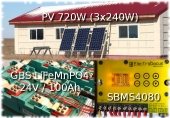




Strong communities make police obsolete.



 1
1




'Theoretically this level of creeping Orwellian dynamics should ramp up our awareness, but what happens instead is that each alert becomes less and less effective because we're incredibly stupid.' - Jerry Holkins




D Nikolls wrote:That is a lot of power.
I have no idea what sort of system specs you are looking at, they sound rather misleading.
There are 3 main things to worry about with a solar system.
1) The batteries. First because they are the biggest limiting factor and ongoing expense.
2) The panels. Pretty darned cheap these days. Ought to last a couple decades easily, but it is hard to test for longevity up front!
3) The inverter/s. Quality is key here.
I left out a bunch; charge controller/s, panel mounting setup, fusing, battery monitoring systems, wiring. But, these are all things that follow naturally; they must be specced to correctly support the key items above.
Once you know how much peak power you will draw, you can choose your inverter/s, to prevent the mad scientist effect, or more realistically, a blown fuse or failed inverter.
Once you know how much power you use over time, and how much sun you can reasonably count on, you can size your battery bank and panel array.
While it is possible for a battery bank to not be able to provide enough current to support the inverters specced, with the sort of major power usage you are talking about this is an unlikely issue.
For example... I live on the wet coast. In CDN$, my chinese LiFePo4 bank cost about $1000 per usable Kw/H, ... It has effectively no manufacturer support and I am not super confident in longevity. A reputable brand with good support might cost 2-3 times this.
I spent 6k+ for batteries, around 4K for a pair of Victron 3000VA inverters, and less than 3K for 10x 300@ panels. Wiring, breakers, charge controllers add up fast, but under 2K for everything. So around $15,000, of which the batteries were 40%. IF you DIY it all, which you certainly should not on a system of this scale without significant experience.
Note that I've only got 2100W of the panels currently mounted.
In summer, I run a 3/4hp pond pump for livestock and garden irrigation, charge a LOT of cordless power tools, use slow cookers and a dehydrator, run my tinyhouse exhaust fans 16 hours a day, and don't worry about running my power hungry laptop all the time. I still have to be a bit careful if I run a big sprinkler for several hours with the pump going the whole time.
In mid winter, I run the small DC fridge, carefully charge up all the powertools on the rare sunny days, and ration my laptop time. These is no surplus to be had.
This system would obviously not have a hope in hell of running your loads, especially in my area.
If I assume your 1/2HP load is about 350W continuous, this system would handle that OK, on sunny summer days. 8.4Kw/H per day.. no sweat, I can make 25KW per day easy.. I just can't store that much. But the 6KW usable is more than enough to get through a night. One night. As long as the next day is also fairly sunny.
I don't want to do the math on running this in winter, because it is just plain depressing. At a glance the consumption described looks like a 6 digit bill to me..
To start figuring the cost, decide how many cloudy days you want to be able to last. Size the usable capacity of your battery bank to be equal to the average daily consumption for that season times that many days, and start looking for prices. Lead acid is cheapest, but doesn't last nearly as long as lithium based stuff, nor can you discharge it as deeply; 50% MAX vs 80% or more.
This is the single biggest system cost; might as well figure out if it's at all practical before carrying on!
Strong communities make police obsolete.







 1
1




Iterations are fine, we don't have to be perfect
My 2nd Location:Florida HardinessZone:10 AHS:10 GDD:8500 Rainfall:2in/mth winter, 8in/mth summer, Soil:Sand pH8 Flat

|
WARNING! Do not activate jet boots indoors or you will see a tiny ad:
Kickstarter Techniques eBook - DRAFT
https://permies.com/t/123522/Kickstarter-Techniques-eBook-DRAFT
|





